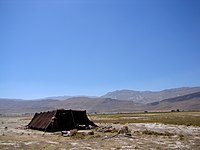
Photo from wikipedia
The production of pasture in Ethiopia was simulated by means of a dynamic model. Most of the country is characterized by a tropical monsoon climate with mild temperatures and precipitation… Click to show full abstract
The production of pasture in Ethiopia was simulated by means of a dynamic model. Most of the country is characterized by a tropical monsoon climate with mild temperatures and precipitation mainly concentrated in the June–September period (main rainy season). The production model is driven by solar radiation and takes into account limitations due to relocation, maintenance respiration, conversion to final dry matter, temperature, water stress, and nutrients availability. The model also considers the senescence of grassland which strongly limits the nutritional value of grasses for livestock. The simulation for the 1982–2009 period, performed on gridded daily time series of rainfall and maximum and minimum temperature with a resolution of 0.5°, provided results comparable with values reported in literature. Yearly mean yield in Ethiopia ranged between 1.8 metric ton per hectare (t ha-1) (2002) and 2.6 t ha−1 (1989) of dry matter with values above 2.5 t ha-1 attained in 1983, 1985, 1989, and 2008. The Ethiopian territory has been subdivided in 1494 cells and a frequency distribution of the per-cell yearly mean pasture production has been obtained. This distribution ranges from 0 to 7 t ha-1 and it shows a right skewed distribution and a modal class between 1.5–2 t ha-1. Simulation carried out on long time series for this peculiar tropical environment give rise to as lot of results relevant by the agroecological point of view on space variability of pasture production, main limiting factors (solar radiation, precipitation, temperature), and relevant meteo-climatic cycles affecting pasture production (seasonal and inter yearly variability, ENSO). These results are useful to establish an agro-ecological zoning of the Ethiopian territory.
Journal Title: International Journal of Biometeorology
Year Published: 2018
Link to full text (if available)
Share on Social Media: Sign Up to like & get
recommendations!